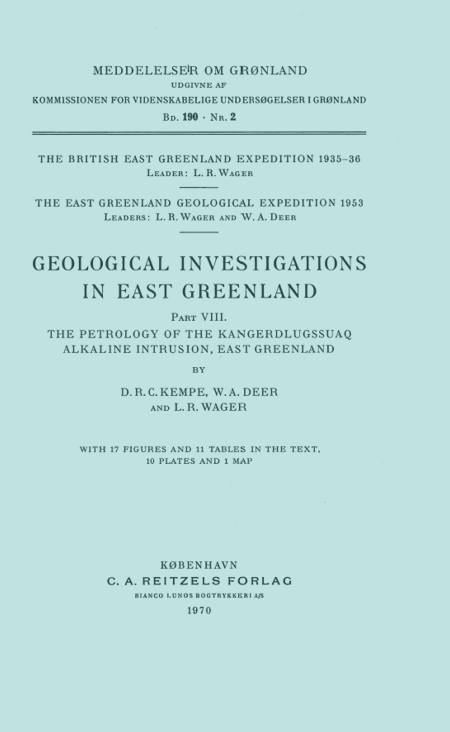Geological Investigations in East Greenland. Part VIII.
DOI:
https://doi.org/10.7146/mog.v190.150328Abstract
The Kangerdlugssuaq alkaline intrusion, of Tertiary age, intrudes the Precambrian metamorphic complex of East Greenland. It was originally overlain by basalts, now removed by erosion, but into which there was considerable stoping, resulting in the incorporation of large basalt xenoliths within the outer part of the intrusion. The syenite mass, 33 km in diameter, has the form of a pile of saucers, centripetally cooled, decreasing in size and silica content upwards and inwards. The lower outer mass is a quartz-nordmarkite which passes gradually with decreasing quartz content into nordmarkite and a quartz- and feldspathoid-free transitional pulaskite. This passes, with the incoming of nepheline and sodalite, into pulaskite and, finally, foyaite. The nordmarkites constitute some 90 per cent of the whole intrusion. The rocks of all the units are cut by a variety of veins and contain pegmatitic
segregations.
The chemistry of the main rocks is discussed with the aid of fourteen analyses; nine analyses of the veins, basalt inclusions and country rocks are also included. The normative compositions of the rocks of the intrusion all occur within the thermal valley of the system Qz - Ne - Ks at PH,O = 1000 bars, representing a transition from an over- to an undersaturated liquid. The original magma is calculated as a quartz-poor nordmarkite. The petrography of the rocks is described, and modal analyses are given. The main mineral in the intrusion is a low-albite - microcline microperthite with a composition of Or38 in the nordmarkites, Or36 in the transitional pulaskite, Or41 in the main pulaskite, and Or55 in the foyaite. The nordmarkites and transitional pulaskite contain phenocrysts of low-albite - orthoclase microperthite (Or29- 28); these are also present in the basalt xenoliths but have a composition of Or18, and are very rich in lime (up to An12). The perthites are rimmed with sodic plagioclase (An 4 ) and constitute up to 90 per cent of the nordmarkites and 50 per cent of the foyaite . Quartz is present in the nordmarkites, the main ferromagnesian mineral of
which is katophorite. In the pulaskites, aegirine (ea. Ac80) and biotite accompany arfvedsonite, both in part derived from the alteration of the amphibole. In the foyaite, nepheline and sodalite constitute up to 40 per cent of the rock, with consequent
reduction in perthite content. Aegirine-augite (Ac 30) and melanite are the main ferromagnesian minerals of the foyaite and both amphibole and biotite are absent or present in very small amounts. Iron oxides (ilmenite in the outer, magnetite in the inner rocks), apatite and sphene are the chief accessory minerals, which include in addition some fluorite, analcite, zircon, perovskite, chevkinite and hiortdahlite; astrophyllite, eudialyte, lil.venite and catapleiite are present in the veins.

Downloads
Published
How to Cite
Issue
Section
License
Coypyright by the authors and the Commision for Scientific Research in Greenland. No parts of the publications may be reproduced in any form without the written permission by the copyright owners.

